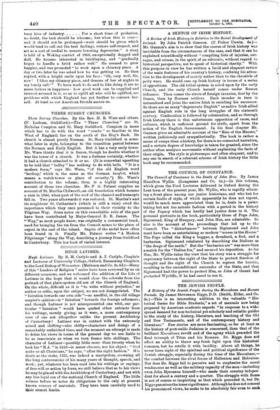THE COUNCIL OF CONSTANCE.
The Council of Constance to the Death of John Hus. By James Hamilton Wyllie. (Longmans and Co. 6s.)—In this volume, which gives the Ford Lectures delivered in Oxford during the Lent term of the present year, Mr. Wyllie, who is rapidly attain- ing a front place among our junior historians, and who but for certain faults of style, of which apparently he does not repent, would be much more appreciated than he is, deals in a pains- taking but not too minute fashion with a period in the history of the Papacy which has hardly had justice done to it. The personal portraits in the book, particularly those of Pope John, Sigismund, King of Hungary, and John Hus, are admirable. So also is the account of the proceedings that led up to the Council. The " disturbances " between Sigismund and John must have been as entertaining as modern "scenes in the House." The Pope called the King a beggar, a drunkard, a fool, and a barbarian. Sigismund retaliated by describing the Italians as "the dregs of the earth." But the "barbarian ass" was more than a match for the "Italian fox," and secured his deposition. As for Hus, Mr. Wyllie takes the view that his story was a struggle for supremacy between the right of the State to protect freedom of thought and the right of the Church to repress the heretic, resulting in the unconditional surrender of the State, and that Sigismund had the power to protect Hue, as John of Gaunt had protected Wycliffe, if he had cared to use it.


















































 Previous page
Previous page